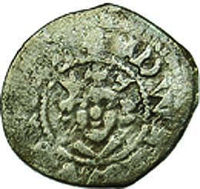020 7636 1188 info [at] coincraft.com
You have no items in your shopping cart.
New Stock September 2023 (Part II)
In this upload w're binging some special items such as we're as Marcus Aurelius Denarii, the first£50 Britannia ever made, and Edward I Farthing and an unusual medal from the region of the world some would call East Turkestan or Uyguristan.
View as
Sort by
Display per page
Filter by attributes
- Denomination
- Drachm
- Pre-Decimal Denomination
- Sixpence (Tanner)
- Florin (Two Shillings)
- Currently shopping by:
- Pre-Decimal Denomination: Farthing or Shilling (Bob) or Halfcrown
Edward I, Farthing Fine
The farthing marked the start of a revolutionary coinage reform by Edward I. Until this time, the penny was the smallest denomination. Low value transactions could be conducted using pennies cut into halves or quarters. The act of cutting pennies into quarters or fourths was how the word Farthing or “fourthing” came about. These silver farthings were introduced by Edward I during the recoinage of 1279. They brought about the end of the practice of cutting coins into halves and quarters. The old coinage and the use of pennies cut into farthings remained legal tender until they were demonitised in August 1280. These coins were the smallest silver coins of the early medieval period and were well circulated and are now over 700 years old, and they are much scarcer than the Pennies. We have been putting these aside for many years and are delighted to offer them to you now, for the first time. Available in Fine, while stocks last.
£99.50
George III, Halfcrown (Small Head) Fine
In 1816, during the end of the reign of King George III, all the old coinage was replaced with new coins and new designs. The Halfcrown was first issued in 1816-1817 but the King hated how they had portrayed him on the coin. So later in 1817 they changed the design to the new smaller head halfcrown. This design lasted only until 1820 when the King died and George IV came to the throne and all the designs changed. The Half Crown is the second largest silver denomination issued, it had a face value of Two Shillings and Sixpence. They were struck in Sterling Silver, dates will be of our choice, but the more you order the more different dates we will try and give you. We have the small head George III Halfcrown available in Very Good and Fine condition, the choice is yours.
£89.50
George VI, Shilling (English) 1946 Choice Unc
The last English Shilling struck in silver. Choice Uncirculated.
£30.00





























